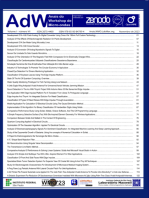Karaokay Microphone Amplifier: With Adjustable Tone Control, Usb Power and Loudspeaker Output
Karaokay Microphone Amplifier: With Adjustable Tone Control, Usb Power and Loudspeaker Output
Uploaded by
Kichiro CarvajalCopyright:
Available Formats
Karaokay Microphone Amplifier: With Adjustable Tone Control, Usb Power and Loudspeaker Output
Karaokay Microphone Amplifier: With Adjustable Tone Control, Usb Power and Loudspeaker Output
Uploaded by
Kichiro CarvajalOriginal Description:
Original Title
Copyright
Available Formats
Share this document
Did you find this document useful?
Is this content inappropriate?
Copyright:
Available Formats
Karaokay Microphone Amplifier: With Adjustable Tone Control, Usb Power and Loudspeaker Output
Karaokay Microphone Amplifier: With Adjustable Tone Control, Usb Power and Loudspeaker Output
Uploaded by
Kichiro CarvajalCopyright:
Available Formats
lektor post Project No.
61
KaraOkay
Microphone Amplifier
with adjustable tone
control, USB power
and loudspeaker
output
By Elektor Labs India
Note: early prototype pictured; deviates in some respects
from final version
Here is an all-analog, lamy on his Muse concerts). IC1a operates
all-through-hole, cheap as a non-inverting amplifier with the electret
& cheerful preamplifier microphone signal applied to pin 3 via coupling
for that perennial prob- capacitor C1, and the bias voltage applied to
lem of getting the micro- the microphone element via R3. IC1a’s ampli-
phone amplification just fication factor A is determined by the ratio
right, which is a challenge of R8 to one of three combinations allowed
not only with the faithful by R4–R7. Let’s call that resistance, Req. At
reproduction of lead vocals switch position ‘1’ i.e. with R5 switched into
during concerts and record- the circuit by S1, the factor will be:
ings, but also with camp-
fire and karaoke-ish perfor- Req = R4 || R5 || R7 = 449 Ω
mances specially when the A(1) = (1 + R8 / Req) = 223.7 ≡ 47 dB
beer takes hold.
The two operational ampli- Likewise with S1 at its center position a factor
fiers of the circuit, IC1a and A(2) of about 14 (23 dB) is selected, and finally
IC1b are contained in s sin- with R6 switched-in (S1 position 3) A(3) works
gle TLC272 package. The out as 60 (35 dB). With selector S1 offering
TLC272 was selected mainly different gains, the circuit can be matched to
for its low noise contribu- different input levels, microphones, vocalists,
tion, which is essential in a and beer levels.
microphone (pre)amplifier The tone control stage is arranged around
as the original signal from the next opamp, IC1b. Here the ratio R16/
the microphone is relatively R15 sets the gain at about 18 dB. The effect
weak (except for Matt Bel- of R14-C2 is, in principle, the same as R4
lektor post | Project No. 61 | 1
lektor post Project No. 61
+5V C15
K1 5 3 47n
2 R1
Bass P1 100k
USB 1 8 C6
330R
C11 C16
6 4 IC1 R9 R13 R10 100p
R3 LED1 R16
100n 220u
50V 4 2M2
10k
12k
10k
R18 C9
10k
C10
* *
1k2
K3 C1 10u 50V
3 4u7 +5V
C4 50V
1 6
100n IC1a 1
2 7 3 6
4u7 IC1b 8 C14
R2 R4 R5 R6 50V 5 5
IN R11 R12 R14 R15 IC2
C3 C8 2
470R
LM386 220u
10k
2k2
1M
270k
4
4k7
4k7
3k3
+5V 7
50V
4n7 10u
2 R8 P2 50V
1 3 K2
R19 100k
P3 C13
470k
S1 Treble
10k
47n
Volume 10k OUT
R20 R7 R17
C5 C7 IC1 = TLC272 C2 C12
10R
27k
10k
1u 10u 2n2 10u
50V 50V 50V
140101-11
and C7: a smaller value of C2 increases the fication is 20, which is recommended here.
lower cutoff frequency. The real tone control For an amplification of 200, fit capacitor C9
however it the RC network inserted between and replace R18 with a wire. With both R18
IC1a and IC1b. Potentiometer P1 sets the and C9 in place the amplification is about 50.
bass level, and P2 the treble level. The two As a good alternative to a dedicated power
capacitors in the network, C15 and C3, behave supply, and in good 201x
as frequency-dependent resistances for alter- fashion the ampli-
nating voltages. fier is powered
The tone control stage is followed by a small over a USB-B
power amplifier based on the venerable LM386 cable via K1, with
in standard configuration complete with interference sup-
Boucherot net-
work C13-R17
to dampen out
the effects of
loudspeaker
impedance
fluctuations
that may cause
motorboating
and other forms
o f i n s t a b i l i t y.
Output power will
be of the order of a few hun-
dred milliwatts driving a small
8-ohm loudspeaker (kept well out
of the microphone’s vicinity).
The LM386’s gain is internally set to 20 to
keep external part count low, but the addi-
tion of external parts R18-C9 between pins 1
and 8 allows the gain to be set to 20, 50 or Note: early prototype pictured; deviates in some
200. Without R18 and C9 the LM386’s ampli- respects from final version.
lektor post | Project No. 61 | 2
lektor post Project No. 61
pression and some buffering afforded by C11 input and USB supply connectors K3 and K1
and C16 respectively. are all on the PCB, avoiding wiring that would
The two opams are biased at 0.5 Vcc with the make the circuit susceptible to hum and noise.
help of voltage divider R19-R20. The photos illustrate a suggested method of
The circuit is built on the printed circuit board housing the amplifier board in a compact,
shown here, which was designed for com- strong but not beer resistant, ABS case.
pactness and low noise. The tone and volume (140101)
controls P1, P2 and P3 as well as microphone
Component List
Resistors C6 = 100pF 50V, Y5P, 0.1’’ pitch
R1 = 330Ω C7,C8,C9,C12 = 10µF 50V, 2mm pitch, 5x11 mm
R2 = 1MΩ C13,C15 = 47nF 50V, X7R, 0.1’’ pitch
R3,R4,R9,R10,R19,R20 = 10kΩ C14,C16 = 220µF, 50V, 5mm pitch
R5 = 470Ω
R11,R12 = 4.7kΩ Semiconductors
R6 = 2.2kΩ IC1 = TLC272 or OPA2350PA
R7 = 27kΩ IC2 = LM386
R8 = 100kΩ LED1 = LED, red, 3mm
R13 = 12kΩ
R14 = 3.3kΩ Miscellaneous
R15 = 270kΩ K1 = USB type-B receptacle, right angle
R16 = 2.2MΩ K2,S1 = SIL pinheader, 0.1’’ pitch
R17 = 10Ω K3 = 3.5-mm stereo jack socket, PCB mount
R18 = 1.2kΩ (see text) S1 = switch, SPDT, center-off
P1 = 100kΩ lin. potentiometer IC socket, DIP-8
P2 = 470kΩ lin. potentiometer Casing, e.g. Bud Industries CU-793, Digikey #
P3 = 10kΩ log. potentiometer 377-1167-ND
PCB # 140101
Capacitors
C1,C11 = 100nF 50V, X7R, 0.2’’ pitch
C2 = 2.2nF 50V, 0.1’’ pitch
C3 = 4.7nF 100V, X7R, 0.1’’ pitch
C4,C10 = 4.7µF, 50 V, 2 mm pitch, 5x11 mm
C5 = 1µF 50V, 2mm pitch
lektor post | Project No. 61 | 3
You might also like
- (Pieki Algo) Signals and Overlays (v.2.0)Document13 pages(Pieki Algo) Signals and Overlays (v.2.0)Rafael Rubio100% (4)
- Acom 1011 Service ManualDocument40 pagesAcom 1011 Service ManualHubert JoriskesNo ratings yet
- SE Case StudyDocument33 pagesSE Case StudyChirag SharmaNo ratings yet
- Schematic DMN-EDC-Board 20190522073450Document4 pagesSchematic DMN-EDC-Board 20190522073450SoeAyeNo ratings yet
- TR310H InformationDocument2 pagesTR310H InformationRodrigoNo ratings yet
- CDV700Pro Construction Tutorial PDFDocument33 pagesCDV700Pro Construction Tutorial PDFjuan9gonzalez_9No ratings yet
- Sound To Light UnitDocument3 pagesSound To Light UnitPhilip CardonaNo ratings yet
- Ic Special Function For Sensor Signal ConditioningDocument101 pagesIc Special Function For Sensor Signal ConditioningLaura TampubolonNo ratings yet
- Electronica PANDORADocument7 pagesElectronica PANDORAEnya Andrea Ribba HernandezNo ratings yet
- Anubis DocumentationDocument9 pagesAnubis Documentationvkpwdcmm25No ratings yet
- Ic302 C1BB00000715Document2 pagesIc302 C1BB00000715Roiser DelgadoNo ratings yet
- DIY Naim MC To MM Mod Sch2Document1 pageDIY Naim MC To MM Mod Sch2tubetymeNo ratings yet
- Elektor Attiny NoiseDocument2 pagesElektor Attiny NoiseKlemensKohlweisNo ratings yet
- UK2010070961Document2 pagesUK2010070961Christopher QuadrosNo ratings yet
- Valve PreamplifierDocument8 pagesValve PreamplifiercnramanNo ratings yet
- 13TR T4DDocument1 page13TR T4Dfox7878No ratings yet
- Low Cost Sine-Wave Generator: 16Hz - 100Khz ApproxDocument7 pagesLow Cost Sine-Wave Generator: 16Hz - 100Khz ApproxmarcosscaratoNo ratings yet
- Irf520 ModDocument1 pageIrf520 Modpatolin_123No ratings yet
- Micro Terror JFETDocument1 pageMicro Terror JFETwalterdadaNo ratings yet
- Clap SwitchDocument1 pageClap SwitchSaravana_Kumar_4984No ratings yet
- Revised Schematic (C) Copyright 1994-2004 PDFDocument1 pageRevised Schematic (C) Copyright 1994-2004 PDFAlex CardenasNo ratings yet
- McBennett VCF - R27 RevDocument1 pageMcBennett VCF - R27 RevAdrianoEngelNo ratings yet
- Tiny Microphone - Preamplifier: Components PlacementDocument1 pageTiny Microphone - Preamplifier: Components Placementedel camachoNo ratings yet
- BigmufpiDocument4 pagesBigmufpinene_guitarNo ratings yet
- Mosfet Audio Driver SchematicDocument1 pageMosfet Audio Driver Schematicapostolos2691No ratings yet
- The Sample and HoldDocument5 pagesThe Sample and Holdmaddy13rocksNo ratings yet
- Roteiro de ProjetoDocument14 pagesRoteiro de ProjetoMaycon DouglasNo ratings yet
- Dual Mic Pre Schematic - SSM2017-Based, But INA217 & THAT1510 Are Possible Subs - Kevin Ross Celestial - ComauDocument1 pageDual Mic Pre Schematic - SSM2017-Based, But INA217 & THAT1510 Are Possible Subs - Kevin Ross Celestial - ComaucrackintheshatNo ratings yet
- AM Transmitter: Mudit AgarwalDocument1 pageAM Transmitter: Mudit Agarwalsubdh neupaneNo ratings yet
- Ocd Datasheet 010817Document5 pagesOcd Datasheet 010817Sebastiano MuratoreNo ratings yet
- Drum Trigger Schem PDFDocument1 pageDrum Trigger Schem PDFER ToNo ratings yet
- Xotic BB Preamp Andy Timmons - SchematicDocument1 pageXotic BB Preamp Andy Timmons - SchematicDavid Brown100% (1)
- 6v6gt Se 12ax7 RevaDocument1 page6v6gt Se 12ax7 RevaAntonio GomesNo ratings yet
- Aion Quantum Ibanez Mt10 Mostortion DocumentationDocument6 pagesAion Quantum Ibanez Mt10 Mostortion DocumentationhaerNo ratings yet
- Generador Inductivo Y Digital: R1 R3 C3 Salida Digital. R13Document1 pageGenerador Inductivo Y Digital: R1 R3 C3 Salida Digital. R13Erick CorzoNo ratings yet
- PWM Signal GenerationDocument4 pagesPWM Signal GenerationPravat SatpathyNo ratings yet
- Write A Short Note On Virtual Ground of Op-Amp? AnswerDocument2 pagesWrite A Short Note On Virtual Ground of Op-Amp? AnswerDon't TouchNo ratings yet
- Subwoofer Filter Rev1 SCHDocument1 pageSubwoofer Filter Rev1 SCHTaulan SyahNo ratings yet
- Mesa MK2C+ SLOCLONEDocument4 pagesMesa MK2C+ SLOCLONEedi spenkNo ratings yet
- Super Mini Micro UCD DiscreteDocument1 pageSuper Mini Micro UCD DiscreteAnggas HadaianNo ratings yet
- High Voltage Power Operational Amplifiers: FeaturesDocument13 pagesHigh Voltage Power Operational Amplifiers: FeaturesramswaruprewaniNo ratings yet
- A 9 Cab 5Document1 pageA 9 Cab 5vkpwdcmm25No ratings yet
- Esq d2k0 Rev03Document2 pagesEsq d2k0 Rev03marcio moratesNo ratings yet
- Cyclic Timer Using 555 1 PDFDocument1 pageCyclic Timer Using 555 1 PDFNguyen Phuoc HoNo ratings yet
- REDD47 Amp SchemDocument1 pageREDD47 Amp SchemSigg KeyoNo ratings yet
- 060105-UK Water DescalerDocument1 page060105-UK Water DescalerOvidiu FratuNo ratings yet
- Mini Bench PSU (Elektor)Document2 pagesMini Bench PSU (Elektor)dardosordiNo ratings yet
- EFM 3534 Noise & S-HDocument3 pagesEFM 3534 Noise & S-HMoseley MirandaNo ratings yet
- Practical-Electronics-1973-09 Phase UnitDocument4 pagesPractical-Electronics-1973-09 Phase UnitJohan TaalanderwijsNo ratings yet
- Muff Malo - Building DocsDocument7 pagesMuff Malo - Building DocsLucio M.No ratings yet
- Cad Praktek Tugas 1.3: Nama: Cakra Rizky Fortuna KLS: To-2A NRP: 0920040020 A. Opamp Layout, PCB, Dan 3DDocument6 pagesCad Praktek Tugas 1.3: Nama: Cakra Rizky Fortuna KLS: To-2A NRP: 0920040020 A. Opamp Layout, PCB, Dan 3DcaktotNo ratings yet
- VOX AC15C1 Service ManualDocument22 pagesVOX AC15C1 Service Manualblondeb3No ratings yet
- Arcadiator Build Doc v1B UpdatedDocument1 pageArcadiator Build Doc v1B UpdatedEdward JonesNo ratings yet
- Anten: 2/5/2010 4:48:37 PM C:/Program Files/EAGLE-5.7.0/untitled - SCH (Sheet: 2/2)Document1 pageAnten: 2/5/2010 4:48:37 PM C:/Program Files/EAGLE-5.7.0/untitled - SCH (Sheet: 2/2)gacon89No ratings yet
- By Sunil Malekar (Elektor Labs India) : March & April 2015Document4 pagesBy Sunil Malekar (Elektor Labs India) : March & April 2015Agnivesh PandeyNo ratings yet
- 10W Amplifier - Double PentodeDocument1 page10W Amplifier - Double PentodeBogdan Alexandru RusuNo ratings yet
- Livewire - Professional Edition - Sensor Lambda - LVWMMMMDocument1 pageLivewire - Professional Edition - Sensor Lambda - LVWMMMMcasifuentesNo ratings yet
- Reference Guide To Useful Electronic Circuits And Circuit Design Techniques - Part 2From EverandReference Guide To Useful Electronic Circuits And Circuit Design Techniques - Part 2No ratings yet
- Analog Dialogue, Volume 48, Number 1: Analog Dialogue, #13From EverandAnalog Dialogue, Volume 48, Number 1: Analog Dialogue, #13Rating: 4 out of 5 stars4/5 (1)
- SUB-Class IGBT Ver. b2Document4 pagesSUB-Class IGBT Ver. b2Kichiro CarvajalNo ratings yet
- Small - Closed Box System part-IIDocument8 pagesSmall - Closed Box System part-IIKichiro CarvajalNo ratings yet
- Knight kg-250 Schematic PDFDocument1 pageKnight kg-250 Schematic PDFKichiro CarvajalNo ratings yet
- OTL - Philips Modelo B6X 15 ADocument8 pagesOTL - Philips Modelo B6X 15 AKichiro CarvajalNo ratings yet
- RB Ta0105a 1Document19 pagesRB Ta0105a 1Kichiro CarvajalNo ratings yet
- Small - Closed Box System Part-IDocument11 pagesSmall - Closed Box System Part-IKichiro CarvajalNo ratings yet
- Elektor PA300 - November, 1995 PDFDocument7 pagesElektor PA300 - November, 1995 PDFKichiro Carvajal100% (1)
- A.F Amp Tweeter ProtectorDocument4 pagesA.F Amp Tweeter ProtectorKichiro CarvajalNo ratings yet
- Datasheet VSpace-Pro-11 (En) 377587Document3 pagesDatasheet VSpace-Pro-11 (En) 377587Kichiro CarvajalNo ratings yet
- Cy Linc Rical Spherical CoordinatesDocument2 pagesCy Linc Rical Spherical CoordinatesharshaNo ratings yet
- Gujarat Technological UniversityDocument2 pagesGujarat Technological Universityfeyayel988No ratings yet
- Physics and Measurement: Conceptual ProblemsDocument4 pagesPhysics and Measurement: Conceptual ProblemsQassem MohaidatNo ratings yet
- Pssa 4Document338 pagesPssa 4MirayamahikaNo ratings yet
- The Passive VoiceDocument8 pagesThe Passive VoiceMayte79100% (1)
- Operations Research AnalyticsDocument24 pagesOperations Research AnalyticsBipllab RoyNo ratings yet
- CSE220 Quiz 01 - 02 (Fall 2022)Document3 pagesCSE220 Quiz 01 - 02 (Fall 2022)Maliha AkterNo ratings yet
- Conveyor DesignDocument159 pagesConveyor DesignAhmed100% (3)
- Sbd10c 100f (Power Supply TV Led)Document6 pagesSbd10c 100f (Power Supply TV Led)Saharuddin SangkalaNo ratings yet
- SSC ThorstenDocument55 pagesSSC ThorstenMichal KowalczykNo ratings yet
- Unit - I: Java BasicsDocument224 pagesUnit - I: Java BasicsChelikani HarshiniNo ratings yet
- Production of Natural Bamboo Fibers-1: Experimental Approaches To Different Processes and AnalysesDocument13 pagesProduction of Natural Bamboo Fibers-1: Experimental Approaches To Different Processes and AnalysesrabiulfNo ratings yet
- Adaptive Asset Allocation: A Primer: Butler - Philbrick - Gordillo & AssociatesDocument30 pagesAdaptive Asset Allocation: A Primer: Butler - Philbrick - Gordillo & AssociatesAlexandreLegaNo ratings yet
- Time Delay in PICDocument2 pagesTime Delay in PICMervin RodrigoNo ratings yet
- Industrial Control SystemsDocument34 pagesIndustrial Control SystemsAmmar OwesNo ratings yet
- Liquid Crystal Bow-Tie Microstrip Antenna For WireDocument5 pagesLiquid Crystal Bow-Tie Microstrip Antenna For WireFelipe RabeloNo ratings yet
- FCC GuideDocument2 pagesFCC GuideEliecer AyalaNo ratings yet
- Goodyear DatasheetDocument8 pagesGoodyear DatasheetasfadsfNo ratings yet
- Physics 13 - Simple Kinetic Molecular Model of Matter - 2Document40 pagesPhysics 13 - Simple Kinetic Molecular Model of Matter - 2Hakim Abbas75% (4)
- Photogeology NotesDocument12 pagesPhotogeology NotesRudra SinghNo ratings yet
- Fiitjee Entrance Sample PaperDocument11 pagesFiitjee Entrance Sample Papersidxb256No ratings yet
- Technical Manual POLO-KLIMADocument72 pagesTechnical Manual POLO-KLIMAYared TarikuNo ratings yet
- The Specifications of Laser Machine (CR-512D)Document7 pagesThe Specifications of Laser Machine (CR-512D)Fersi HabibNo ratings yet
- Horizontal Tank PDFDocument7 pagesHorizontal Tank PDFhamadaniNo ratings yet
- Thin-Walled Structures: Zhiyuan Fang, Krishanu Roy, Boshan Chen, Chiu-Wing Sham, Iman Hajirasouliha, James B.P. LimDocument19 pagesThin-Walled Structures: Zhiyuan Fang, Krishanu Roy, Boshan Chen, Chiu-Wing Sham, Iman Hajirasouliha, James B.P. LimganeshNo ratings yet
- 10 Chord Scales Via Modal TheoryDocument5 pages10 Chord Scales Via Modal TheoryJoaoPedroCéNo ratings yet
- Digitone Guide To FM SynthesisDocument40 pagesDigitone Guide To FM SynthesisSubhash Chandra BoseNo ratings yet
- Trigonometric FunctionsDocument10 pagesTrigonometric FunctionsEdi MuhammNo ratings yet


































































































